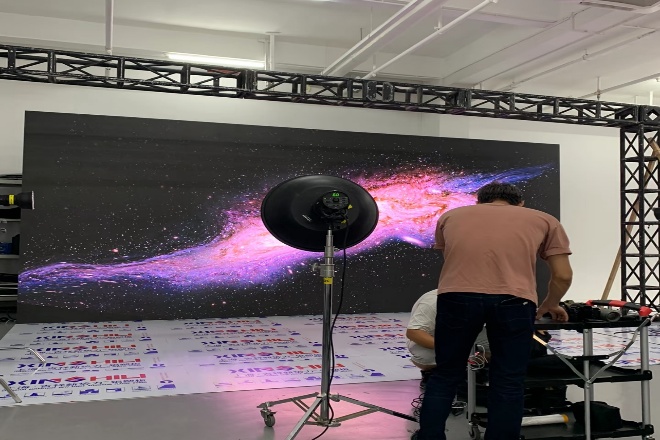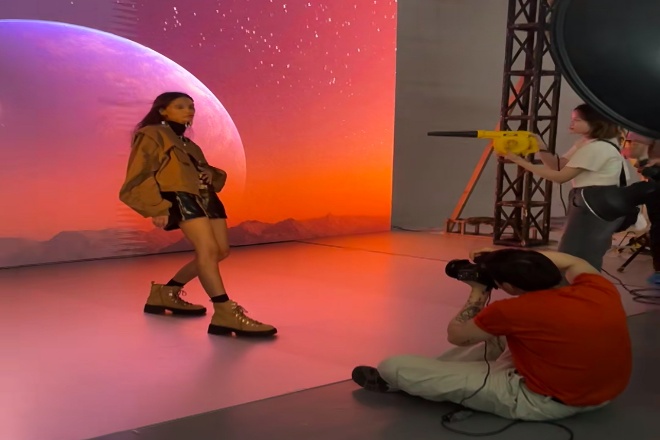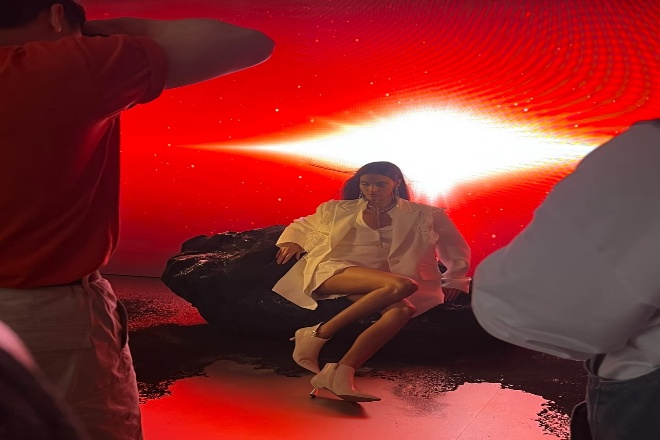介绍

在数字技术与创意艺术的交汇处,工作室正在迎来一场技术革命。作为这场变革的先行者, LED显示屏 已经从幕后走出来,在演播室里大放异彩。
那么,LED显示屏如何在影楼中大放异彩,成为摄影师、创作者的得力助手呢?本文旨在深入探讨LED显示屏如何在影楼中发挥其独特的魅力。
1、演播室使用LED显示屏有哪些优势?
1).实用性强:
想象一下走进摄影棚,不再是单调的绿幕或有限的实体景物,而是一个由LED显示屏组成的梦幻世界。在这里,科技与艺术交织,创造出前所未有的拍摄体验。
LED显示屏在演播室的应用,犹如打开了无限创意的大门,让每一次快门都成为视觉的盛宴。接下来我们就来聊聊LED显示屏在演播室中让人眼前一亮的优势。
2). 触手可及的视觉盛宴
- 高清晰度:
高 解决 LED显示屏让每一个细节都清晰可见,无论是浩瀚的星空,还是细腻的纹理,都能一一呈现,让演员仿佛置身于真实的场景之中,观众也能感受到前所未有的视觉震撼。
- 色彩盛宴:
色彩是影视作品的灵魂,LED显示屏的色彩还原能力让每一帧画面都绚丽多彩,无论是晨曦的温柔,还是夜色的深邃,都能精准捕捉,为作品增添无限风采。
- 动态变化:
不再局限于静态的背景,LED显示屏可以根据剧情的需要实时变换场景,从日出到日落,从沙漠到海洋,只需一键切换,让创意无限延伸。
3).省时省力,效率倍增
- 降低成本:
再也不用为搭建复杂场景而烦恼,LED显示屏大大降低了场地、道具、布景的成本,一次投资,多种用途,超高性价比。
- 速度加速度:
实时预览功能使得导演和摄影师无需等待后期处理就可以在片场看到最终的效果,大大缩短了拍摄周期。
而且虚拟背景的灵活性使得拍摄更加顺畅,减少因场景调整而浪费的时间。
4). 无限创意,自由飞翔
- 无界场景:
LED显示屏打破了物理空间的限制,让想象力成为唯一边界,无论是穿越回古代,还是探索未来世界,只需要一块屏幕就能实现。
- 自由创作:
不再受现实条件的束缚,导演和摄影师可以充分发挥创造力,调整光线、色彩、背景,甚至创造出一个完全虚构的世界,这种自由让每一部作品都独一无二。
5). 绿色拍摄,环保第一
- 资源节约:
与传统拍摄方式相比,LED显示屏减少了大量实物布景和道具的使用,减少了资源消耗和环境污染。绿色拍摄,从我做起。
- 数字化转型:
LED显示屏的应用是影视制作数字化转型的一部分,随着科技的进步,影视制作将更加高效、环保,减轻地球负担,为艺术加分。
2、演播室LED显示屏必须满足哪些条件?

为了满足专业拍摄的需要,演播室LED显示屏必须满足一系列严格的技术和性能条件,下面就这些条件进行详细的总结:
1). 技术规格及性能要求
- 高分辨率和优良的图像质量:
演播室LED显示屏需要具有较高的分辨率才能呈现细腻清晰的图像。高分辨率意味着更多的像素,可以更好地还原虚拟背景或特效的细节。
显示屏需要具备较高的亮度,以保证在各种光照条件下都能清晰可见。同时,广视角设计允许摄像机从不同角度拍摄,捕捉到完整的画面。
- 高色域和色彩还原:
演播室LED显示屏应具有广泛的色域覆盖范围,以呈现丰富的色彩。同时,出色的色彩还原能力可以保证虚拟背景和真实镜头的色彩一致性。
- 高的 刷新率 低延迟:
高刷新率可以减少画面闪烁和拖影,保证拍摄画面的流畅度;低延迟意味着显示器可以快速响应输入信号,减少画面与相机的同步问题。
- 无缝拼接及弧形设计:
对于大型演播室来说,可能需要将多块LED显示屏拼接起来,因此显示屏需要具备无缝拼接技术,保证画面连续不间断。
此外,曲面设计能够更好地适应拍摄需求,提供更加沉浸感的拍摄体验。
2).操作方便、稳定
- 易于安装和调试:
演播室LED显示屏需要易于安装和调试,以节省时间并降低安装成本。这包括轻量化的机身设计、快速的拼接安装、以及简单的调试过程。
- 稳定性强:
显示屏需要长时间稳定运行,不出现闪烁、黑屏等故障,这就要求显示屏具有很强的稳定性和可靠性。
- 支持多种控制方式:
显示屏需支持多种控制方式,如遥控器、触摸屏、电脑控制等,满足不同的拍摄需求。
3). 环境适应性及耐久性
- 环境适应性强:
演播室内的光线、温度等环境因素多变,显示屏需具有较强的环境适应能力。
比如需要能在不同的光照条件下保持稳定的显示效果、在不同的温度范围内正常工作。
- 防水、防尘、防潮:
显示屏需要具备一定的防水、防尘、防潮能力,以应对演播室内可能存在的恶劣环境。
这有助于延长显示屏的使用寿命,降低故障率。
- 高耐用性:
摄影棚内的拍摄工作往往持续时间长、强度大,显示屏需要具备较高的耐用性以应对长时间的工作需要,这包括耐磨、耐冲击、抗老化等特性。
4). 特殊拍摄要求
- 无莫尔条纹:
摩尔纹是影棚拍摄中常见问题之一,显示屏需要采用特殊的技术来消除摩尔纹现象,保证拍摄画面的质量。
- 与相机同步:
显示屏需要能够与摄像机同步,以保证拍摄画面的实时精度。这包括对帧率同步、色彩同步的要求。
- 定制服务:
根据不同影棚及拍摄项目的需求,显示屏可能需要提供定制化服务,包括尺寸、分辨率、亮度、曲率等方面的定制要求。
3. LED显示屏在演播室可能遇到的技术挑战及解决方案
1). 莫尔条纹问题:
莫尔纹是两个具有周期性结构的图案(如LED显示屏的像素网格和摄像机的传感器网格)由于空间频率相似而重叠时产生的干涉条纹。在演播室中,莫尔纹会严重损害画面的清晰度和美观度。
摩尔纹的存在会让画面显得粗糙、不自然,甚至会误导观众对画面真实性的判断,大大降低拍摄作品的专业性与观赏性。
1.1). 莫尔条纹问题的解决方法:
使用景深较浅的相机:通过调整相机的光圈和焦距,使拍摄的画面的景深变浅,从而减少莫尔条纹的范围。
调整拍摄角度和距离:通过改变摄像机的拍摄角度和与LED显示屏的距离,破坏摩尔纹产生的条件,使其不再明显。
使用防摩尔纹滤光镜:在摄像机镜头前安装专门的防摩尔纹滤光镜,通过光学原理消除或减弱摩尔纹的影响。
2). 灯光搭配问题:
LED显示屏的光线输出在色温、亮度、色彩饱和度等方面可能与演播室中其他光源(如自然光、灯光等)不匹配。光线不匹配会造成画面色彩不平衡、明暗对比不自然,降低演员与背景的融合度,影响整体拍摄效果。
2.1). 灯光匹配问题的解决方法:
- 精确校准光线:
使用专业的灯光校准工具,对演播室内的LED显示屏及其他光源进行精确校准,确保其色温、亮度、色彩饱和度等保持一致。
- 使用柔光滤镜或烟雾:
在LED显示屏前增加柔光滤光片或者使用烟雾机产生轻微的烟雾,可以使光线变得柔和,使光线更加均匀、自然,减少因光线不匹配带来的问题。
- 后期色彩处理:
在后期制作阶段,通过调色软件对画面进行精细调整,使演员与背景之间的光线更加和谐统一。
3). 透视关系问题:
在演播室中,当演员与LED显示屏之间的距离或角度发生变化时,由于透视原理,显示屏上的背景图像可能会发生变形或扭曲。
透视关系处理不当会破坏画面的空间感和真实感,使观众难以沉浸在故事中,降低作品的沉浸感和代入感。
3.1). 透视关系问题的解决:
保持演员与摄影机、屏幕的距离:通过合理安排拍摄场景,保持演员与摄影机、LED显示屏的适当距离,减少透视扭曲。
- 使用透视校正技术:
在后期制作阶段,利用透视校正技术对画面进行调整,恢复正确的透视关系。
- 选择正确的拍摄角度:
在拍摄过程中,根据透视原理选择合适的拍摄角度,使得背景画面与演员的透视关系更加自然、协调。
4、演播室LED显示屏未来的发展如何?

1).更高的分辨率:
- 趋势预测:
随着显示技术的不断进步,演播室LED显示屏的分辨率也会不断提高,更高的分辨率意味着更多的像素,可以呈现出更加细腻清晰的图像。
- 影响分析:
高分辨率的LED显示屏将使虚拟背景更加逼真、细节更加丰富,为摄影师和导演提供更广阔的创作空间。同时,高分辨率也有助于减少摩尔纹等问题的发生,提高画质。
2).更高的刷新率:
- 趋势预测:
未来LED显示屏的刷新率还会不断提高,高刷新率意味着更快的画面更新速度,可以减少运动模糊和拖影。
- 影响分析:
在演播室中,高刷新率的LED显示屏会让虚拟背景和真实画面更加同步,拍摄出的画面更加流畅自然,这对于拍摄高速运动场景或者需要精细画面控制的场景尤为重要。
3). 更低延迟:
- 趋势预测:
随着技术的不断进步,LED显示屏的响应时间将进一步缩短,实现更低的延迟。
- 影响分析:
低延迟LED显示屏将使虚拟背景和现实图像的同步更加准确,减少由于延迟而导致的图像不同步的问题。
这对于拍摄需要高精度同步的场景(如舞蹈、武术等)尤其重要。
4).更先进的色彩管理和校准技术:
趋势预测: 随着色彩科学与显示技术的融合,LED显示屏将拥有更加先进的色彩管理和校准技术。
影响分析: 这将使LED显示屏在演播室中呈现的色彩更加准确、丰富,与现实图像的色彩匹配度更高,同时也有助于减少色彩失真等问题,提高画质。
结论
综上所述,LED显示屏凭借其优异的性能、灵活的应用、不断的技术创新,在演播室中发挥着重要作用。
它不仅为影视制作带来了前所未有的创作空间,也以其出色的表现力和效率推动了整个行业的进步。
最后,如果你想了解更多关于LED显示屏的信息, 请与我们联系。
